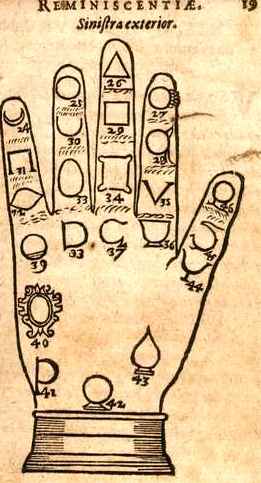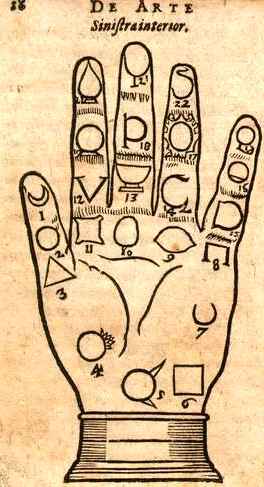|
Palmistry There is a long tradition of human beings trying to unravel the future through virtually every imaginable means. And in almost every form of divination, there is a grain of common sense.
There is a long tradition of human beings trying to unravel the future through virtually every imaginable means. And in almost every form of divination, there is a grain of common sense.Tarot can be said to invoke Jungian archetypes to characterize the elements of our perception of the universe. The i-Ching is in many respects a reasonable model of processes in physical systems. Seeing the future in dreams is surprisingly feasible in a world where Quantum Physics applies. You can even construction a decent-sounding (albeit intellectually flimsy) rationalization for the general concept of Astrology under the auspices of chaos theory. Palmistry, alas, is the red-headed stepchild of divination systems. There's just no good reason to think it might work no matter how loosely you apply the strictures of "science." What it lacks in credibility, palmistry makes up for in drama. There's nothing quite like reading palms for a moment of drama especially if you happen to be a mysterious gypsy with a husky Marlene Dietrich-style voice. The theory itself is pretty basic. The lines on your hands are said to describe important elements of your life, ranging from your success in love to your allotted span of years. It's a great romantic notion. Now, in vaguest principle, some of this information is in fact encoded in your body somewhere, whether it be your DNA, your neural pathways or simply the stiffness of your arteries. However, you'd be hard-pressed to find anyone who can explain why these characteristics would manifest themselves as creases on your hand, or why any given person should be particularly qualified to judge the content of those creases.
There are various lines on the hand which supposedly chart to the days of our lives (much like sands through an hourglass). The most famous of these (and the most frequently consulted by 9-year-olds first discovering the exciting world of alternate spiritualities) are the life line (life expectancy), heart line (success in love, or lack thereof) and a few hatch marks down the side of the hand which are supposed to indicate how many children one may expect. If the practice of palmistry pretty much stopped there, it would no doubt rest in the same general category as the scientific pursuit of how to break your mother's back by stepping on sidewalk cracks (an area surprisingly neglected by most major university programs). But there's sooooooo much more. And what's really fascinating is just how pedantic and tedious most of it is. Virtually every mark you can find on your hand is charted to some portent of meaning by one person or another. It's tempting to throw the "New Age" slur over the whole mess of practitioners and move on, but the practice of palmistry differs from the mass of New Age practices in that it never really went out of style so that it could have a proper renaissance. Like tuberculosis, it's just always been there. The Catholic Church banned palmistry during the Middle Ages, but at the same time embraced it as a method of finding witches to burn. Through the 17th, 18th and 19th centuries, the practice was commonly accepted, and even studied in universities as a form of Physiognomy.
Persisting into the 20th century with little dampening of enthusiasm, the adherents of palmistry did at least pick up some pointers from the birth of the New Age movement in the 1960s. Those wishing to learn more about reading palms may now treat themselves to thousands on thousands of pages of hifalutin verbiage which purports to explain how it could possibly be that these tiny lines on your hand could portray your life in any reasonable way.
|
 Most estimates of the origins of palmistry run back about 3,000 years, which is probably a low estimate since people had hands for a long time before that. It's known to have been practiced in China, Egypt and India, at the very least.
Most estimates of the origins of palmistry run back about 3,000 years, which is probably a low estimate since people had hands for a long time before that. It's known to have been practiced in China, Egypt and India, at the very least. 